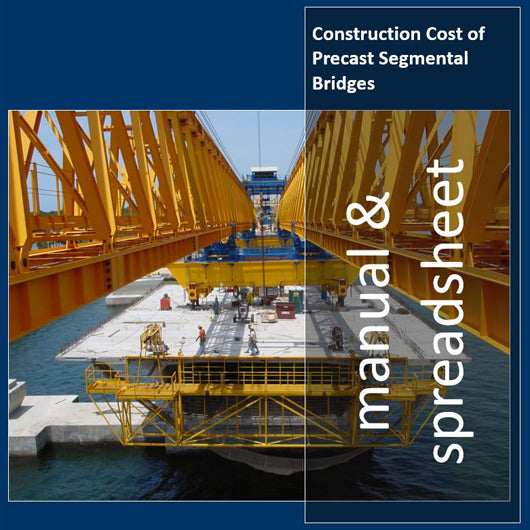
Construction Cost of Precast Segmental Bridges
134 pages & estimation spreadsheet
Regular price
$ 225.00
Sale
Estimating the construction cost of a precast segmental bridge is a complex task that includes the analysis of costs, risks and opportunities of three production lines:
- Segment fabrication in a precasting facility with the short- or long-line method;
- Segment transportation with trucks, trains or barges;
- Span-by-span or balanced cantilever erection of precast segmental spans with ground or floating cranes, lifting frames and self-launching gantries.
In 134 pages, the eManual explains how to estimate the construction cost of a precast segmental deck. The fabrication cost of the segments includes analysis of the setup cost of different types of precasting facilities and analysis of the production costs of the short- and long-line method. Segment transportation includes trucking, trains and barges with or without intermediate staging areas. Segment erection includes span-by-span and balanced cantilever construction and the setup and production costs of the different types of special erection equipment.
The companion estimation spreadsheet includes 1004 cost items (yes, you have read well: one thousand and four) and four columns for each cost item. The first column identifies the construction cost, the second column identifies the opportunities (potential of cost savings), the third column identifies the risk (potential of extra costs), and the fourth column is the total (construction cost minus opportunities plus risks). Row by row, the sum of the second and third column identifies the net combined risk profile for that cost item.
For the three production lines, costs, opportunities and risks are grouped into major cost components:
- Setup of production lines
- Direct labor
- Permanent materials and subcontractors
- Amortization of equipment
- Expendable materials
- Energy
- Indirect costs
- Other costs
E-Manual and estimation spreadsheet are indispensable working tools for bridge owners, designers and constructors interested in the design, bidding and construction of precast segmental bridges. For professionals with consolidated experience of precast segmental technology, the publication will help to rationalize cost and quantified risk analysis during the bidding process and cost recording during production. For professionals with less experience, eManual and estimation spreadsheet will also be a precious guide not to forget cost, opportunity and risk items during the bidding process.
Combined with Span-by-Span Construction of Precast Segmental Bridges (134 pages), the monographs provide 268 pages of exhaustive coverage of all the construction methods and all the types of special equipment for span-by-span construction of precast segmental bridges. They cover the entire construction process, explain how the segment erection method influences bridge design and segment fabrication, and explore bridge design for modularity and the factors that drive the choice between precast segmental technology and in-place casting.
The eManuals explain the short-line method, the operations of casting cells for constant- and varying-depth segments, and the geometric design of the deck for standardized production of atypical segments and geometry correction with the typical segments. They also explain how to generate the casting curve in relation to precasting sequence, erection sequence and time-dependent effects, the geometry control of short-line casting (inclusive of commercial software programs and how they work) and the progressive correction of geometry errors.
The eManuals also explore the long-line method, post-casting operations, different organizations of the stockyard, and segment delivery and epoxy gluing at the erection site. Last but not least, the monographs explain loading, kinematics, performance, productivity and structure-equipment interactions of twin-truss overhead self-launching gantries, single-girder overhead gantries comprising main girder and self-launching underbridge, and underslung gantries, and provide exhaustive guidance on the analysis of construction costs, risks and opportunities of precast segmental bridges.
If then you add Balanced Cantilever Construction of Precast Segmental Bridges (81 pages), the monographs provide 349 pages of coverage of all the construction methods and all the types of special construction equipment for precast segmental bridges. If you are interested in the design, bidding, construction and inspection of precast segmental bridges, the eManuals Project will provide you with a unique wealth of knowledge, learning, insights and unique working tools. If you thought that ASBI Construction Practices Handbook for Concrete Segmental and Cable-Supported Bridges was the international reference for the design and construction of precast segmental bridges, you will be greatly surprised.
